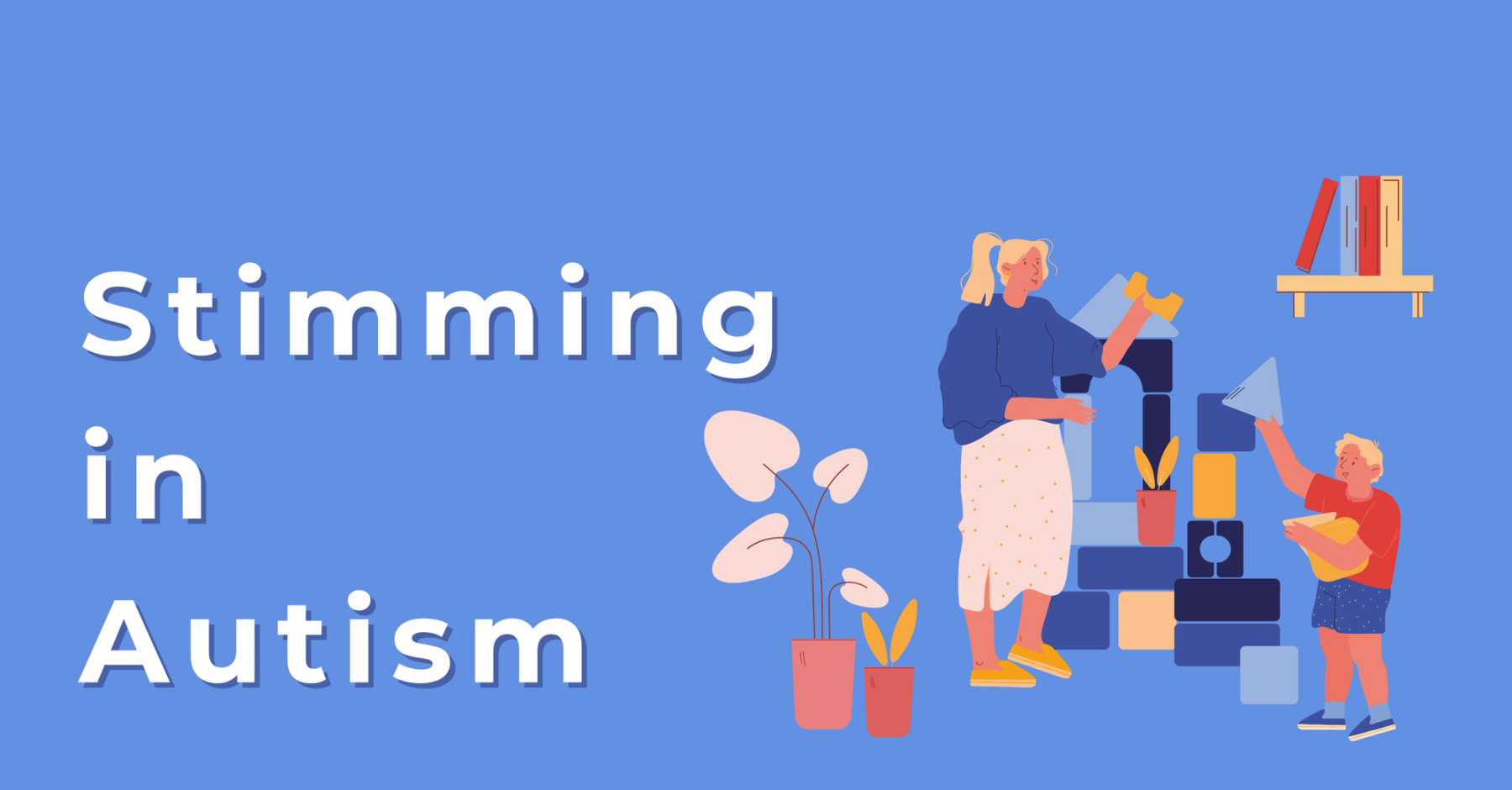April 6th, 2022

Think back to when you were a child and learning to self-soothe: what helped you? What behaviors did you exhibit when attempting to find comfort? Some children will suck their thumb, some will rub their heads, and some may engage in more harmful behaviors such as hitting themselves or banging their heads on the floor.
These actions, known as stimming, are defined as "stereotyped or repetitive motor movements." (Kapp, S. et al., 2019). Most children will grow out of this phase as they get older, but some children will continue to stim into their adolescent and even adult years. Although some adults who are not on the spectrum may engage in stimming, stimming is a frequent symptom of Autism, and often the most obvious symptom.
The American Psychological Association states "Autism Spectrum Disorder (ASD) refers to a neurodevelopment disorder characterized by difficulties with social communication and social interaction and restricted and repetitive patterns in behaviors, interests, and activities."
Stimming is one of the main characteristics of Autism Spectrum Disorder in both children and adults. As people with autism age, stimming behaviors can look different but often they never fully disappear.

People with Autism stim for various reasons, including feeling nervous, uncomfortable, agitated, or excited. All of these reasons have one thing in common: self-soothing. Stimming is a way for people to “find their center.”
Stimming may be presented in non-injurious and non-disruptive activities such as rocking back and forth whether sitting or standing. Some individuals who stim may stim to a point of self-injury such as banging their head on floors and walls.
For people with Autism, stimming is a way to calm themselves and channel their energy when feeling uncomfortable, agitated, anxious, etc. While some people who are feeling anxious or restless will take a walk or turn to music, people with Autism are more likely to take comfort in stimming activities. These stimming activities could include tapping their foot, shaking their leg, flapping their arms, or seeking out compression with squeezing or weighted blankets.
People with Autism struggle more with emotion regulation and learning to self-soothe, so stimming may look different for them and include self-injurious and disruptive activities.
Additionally, people with ASD often have trouble communicating and struggle to identify their emotions. Communicating "I am uncomfortable; I am agitated; I am scared; I am excited;" can be difficult so stimming can be another way for them to communicate these feelings.
For people with ASD, stimming is a way of self-stimulation, a means of regaining control when their emotions become heightened or in situations in which they have no control. People with ASD need to stim to function in a world where they experience neurodiversity.

Masking in people with ASD is different from stimming. Masking is the act of hiding stimming behaviors and other characteristics of Autism. Masking in people with Autism can resemble behaviors such as forceful eye contact, mirroring gestures, copying a smile or another facial expression, hiding or decreasing stimming behaviors, and sitting through triggering sensory activities such as loud noises or bright lights.
People with Autism will mask for different reasons, including embarrassment, safety from bullying and stigma, obtaining employment or getting ahead at work, forming friendships and romantic relationships, and simply fitting in and feeling like they belong.
Think about a time in your life when you were gifted a piece of clothing that you found to be uncomfortable, but you had to wear it anyway to appease the person that gave it to you - this is how it feels for people with Autism to mask.
People with ASD are resourceful when needed due to their brains working differently, allowing them to be neurodiverse. People with Autism learn to mask by studying others and watching videos to learn to communicate. For people with Autism, every interaction can be a learning opportunity. Many do not understand specific social cues such as body language, facial expression, tone of voice, personal space, and reading emotions.
Stimming discretion is another way people with ASD mask, and most learn early, usually due to bullying or being self-conscious about it. Some people with Autism will also learn to replace more distracting stimming behaviors with less subtle ones.
An example of this would be someone whose stimming behaviors are flapping their arms and will instead tap their foot. Someone whose stimming behavior is to rock back and forth will be entirely still around those they do not trust or want to see it. People with Autism must learn how to do these things to fit in or “fake it until they make it” by masking.

For people with Autism, masking is an incredibly stressful task. A person with Autism may find it difficult to maintain eye contact when engaging in conversation. They must work harder to focus on not looking away or appearing uninterested.
People with Autism need to put in more effort than others to keep up with the world around them. Pretending to understand and converse when you do not understand sarcasm or different jokes is also tricky for those with Autism.
Masking to fit in can have both short and long-term mental health effects on people with Autism. Short-term effects can include sadness, discomfort, and exhaustion. Long-term effects can present as anxiety, depression, self-esteem issues, identity crisis, increased suicidal thoughts, and burnout.
Someone with Autism who masks very well may also not be diagnosed until much later in life, resulting in heightened mental health issues and difficulty getting help. Numerous people with autism find it burdensome to mask, hiding their true identities, leading to an identity crisis.
Imagine feeling forced to fit into a world you do not feel like you belong in, like trying to push a cube into a circular-shaped hole. When babies learn to identify and discern shapes, this is often the case; they become frustrated and start crying, not understanding why the pieces do not fit. People with autism feel like this when masking. Feelings of being scared, confused, and frustrated can arise because a person with Autism often does not understand, and often they do not know why they do not understand, despite so desperately wanting to make it work.
Coping with masking is essential, and there are many ways to achieve this. Some coping mechanisms to help not mask are fidget items. Some people with Autism also respond well to music when feeling overwhelmed. Different scents to smell and softer materials to touch may be soothing for those without sensory issues.
Education can be another powerful tool. Learning how stressful interactions impact mental health can help identify coping skills to utilize in those situations.
Other coping mechanisms can include cognitive-behavioral therapy and dialectical behavioral therapy techniques. These will teach them to alter their thinking and learn emotional management.
Lastly, another coping mechanism is accepting the diagnosis and owning it. Being proud of who they are and their contributions to the world. The world needs their unique view.
Written By: Emily Shelton, LCPC, CADC, CRSS
Reference: Kapp, S. K., Steward, R., Crane, L., Elliott, D., Elphick, C., Pellicano, E., & Russell, G. (2019). People should be allowed to do what they like: Autistic adults' views and experiences of stimming. Autism: the international journal of research and practice, 23(7), 1782-1792.
At Clarity Clinic, we have highly trained staff who specialize in therapy and psychiatry services. To learn more about how we can support your mental health, call Clarity Clinic at (312) 815-9660 or schedule an appointment today.
Our Services
Virtual/Online CarePHP and IOPAdult PsychiatryChild & Adolescent PsychiatryAdult TherapyChild & Adolescent TherapyCouples CounselingFamily TherapyGroup TherapyPsychological TestingTranscranial Magnetic Stimulation (TMS)